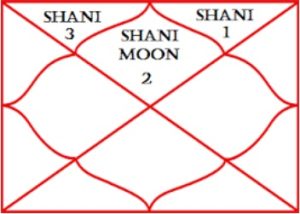Sadesati
In Vedic astrology, the word “Sade Sati” refers to a period of roughly seven and a half years during which the planet Saturn moves through the first, second, and 12th houses from the natal moon sign. It is seen as a difficult period full of challenges and hardships in traditional Hindu astrology.
The following summarises the meaning of each of these houses:
12th House: The 12th house is associated with loneliness, loss, expenditures, and international travel.
First House: The self, personality, health, and vigour are all represented by the first house.
Second House: The Second House is symbolic of morals, speech, family, and money.
It is stated that as Saturn moves through these houses from the moon sign, it will provide a number of difficulties and roadblocks pertaining to the domains these houses regulate. During this time, people frequently encounter stress, delays, setbacks, and hurdles in their lives. But it’s important to realise that the consequences of Sade Sati might differ according to a person’s natal chart, the position and power of Saturn, and other astrological elements.
Not everyone experiences Sade Sati in the same manner, and depending on personal circumstances and how one handles the difficulties it poses, its impact can either be lessened or increased. It’s also important to remember that Vedic astrology provides cures and rites to assist people in navigating difficult planetary transits like Sade Sati.
Are you eager to learn the most refined astrology??? Click the link https://vedicastro.in/courses/kp-astrology-course-2024/ref/2/
Ashtavarga
The intricate system known as Ashtakavarga, or Ashtavarga, is employed in Vedic astrology to evaluate the advantages and disadvantages of each planet in a horoscope. It’s a system of rating planetary positions according to where they fall in a person’s horoscope or birth chart. The Sanskrit terms “ashta” (eight) and “varga” (division) are the source of the name “Ashtakavarga”.
Here is a summary of Ashtakavarga’s operation:
Calculation: In Ashtakavarga, the planetary positions in a given sign or house of an individual’s birth chart are determined, and points are allocated according to the planetary strengths and weaknesses in that sign or house.
Point Distribution: Every planet allots points to a sign or house according to how strong or weak it is in that area. Positive points are contributed by benefic planets like Jupiter, Venus, and Mercury, and negative points are contributed by malefic planets like Saturn, Mars, and the Sun. The position of the Moon is also considered.
Cumulative Scores: The overall number of points earned in each sign or house represents the person’s strength or weakness in that particular area of life. Lower scores denote difficulties or challenges, whereas higher values imply favourable conditions.
Forecast: Ashtakavarga scores are used by astrologers to forecast a person’s future in a number of areas, such as relationships, profession, health, and general well-being. Lower ratings may indicate difficulties or barriers, while higher scores in particular houses may reflect positive results in those areas.
In Vedic astrology, Ashtakavarga is a useful instrument for giving in-depth understanding of the subtleties of an individual’s birth chart and for directing astrological interpretations and forecasts. Accurately interpreting Ashtakavarga charts and obtaining significant life insights necessitates knowledge and meticulous examination.
SadeSati Analysis with Ashtavarga
In Vedic astrology, the term “Sade Sati” describes a period of seven and a half years during which the planet Saturn moves through the natal moon’s twelfth, first, and second houses. It is commonly known that this time is hard and demanding and that it frequently brings with it a variety of challenges and hardships in various areas of life. However, it is also seen as a chance for significant personal growth and change. People go through hardships during Sade Sati, which forces them to develop inner fortitude and perseverance and promotes progress in the face of hardship.
Do you notice that during Sade Sati how some people fly to stardom and get a lot of money while others face a lot of challenges and hardships?
It’s important to remember that Sade Sati doesn’t always involve hardships all the way through.
Ashtakavarga provides an easy way to evaluate Sade Sati’s effects.
Ashtavarga and Kakshya
As we know about Ashtavarga in the Vedic astrology system Ashtakavarga assesses a birth chart’s planets’ power. It can also be used to ascertain an individual’s auspicious and inauspicious periods, as well as the areas of life that the planetary transits will have the greatest impact on.
Kakshya
An important part of Ashtakavarga is Kakshya, which aids in determining the results of planetary transits to a specific time frame. Every sign in the prastara ashtakavarga system receives benefic points from eight sources, which include the ascendant and the seven planets. As a result, every sign is divided into eight pieces, each of which is called a Kakshya. The planets that govern each Kakshya are as follows: Saturn, Jupiter, Mars, Sun, Venus, Mercury, Moon, and Ascendant are the order of Kakshya lords.
Are you eager to learn the most refined astrology??? Click the link https://vedicastro.in/courses/kp-astrology-course-2024/ref/2/
The Golden Rule
When a lord has contributed a Bindu (point) to Saturn’s Ashtakavarga, and Saturn is travelling through the Kakshya (subdivision) of that lord during Sade Sati, it is generally auspicious. On the other hand, things might not turn out as well if this requirement is not satisfied.
For instance, let’s consider Saturn’s transit in the sign of Aquarius starting from January 17, 2023. During the first Kakshya from January 17 to February 18, Saturn governs itself as the lord. If Saturn contributes a bindu in its own Binnashtakavarga for the sign Aquarius, which can be determined from the Prastaraka chart of Saturn, then the outcomes during that period tend to be favorable.

